EIT Research Proposal: Assessing Student's Perception of E-Learning
VerifiedAdded on 2023/06/10
|38
|9614
|274
Report
AI Summary
This research proposal aims to assess student perceptions of e-learning at the Eastern Institute of Technology (EIT) in New Zealand. The study intends to survey 500 students across three campuses using questionnaires to understand their awareness, perceived usefulness, and attitudes towards e-learning. The proposal includes a literature review covering definitions and types of e-learning, success factors, challenges, and related studies, using the Technology Acceptance Model (TAM) as a theoretical framework. The research methodology outlines the study design, target population, sampling techniques, data collection, and analysis methods, with ethical considerations addressed. The expected outcomes focus on students' understanding of e-learning, its perceived benefits, and their overall attitude, aiming to inform EIT on how to improve e-learning services.
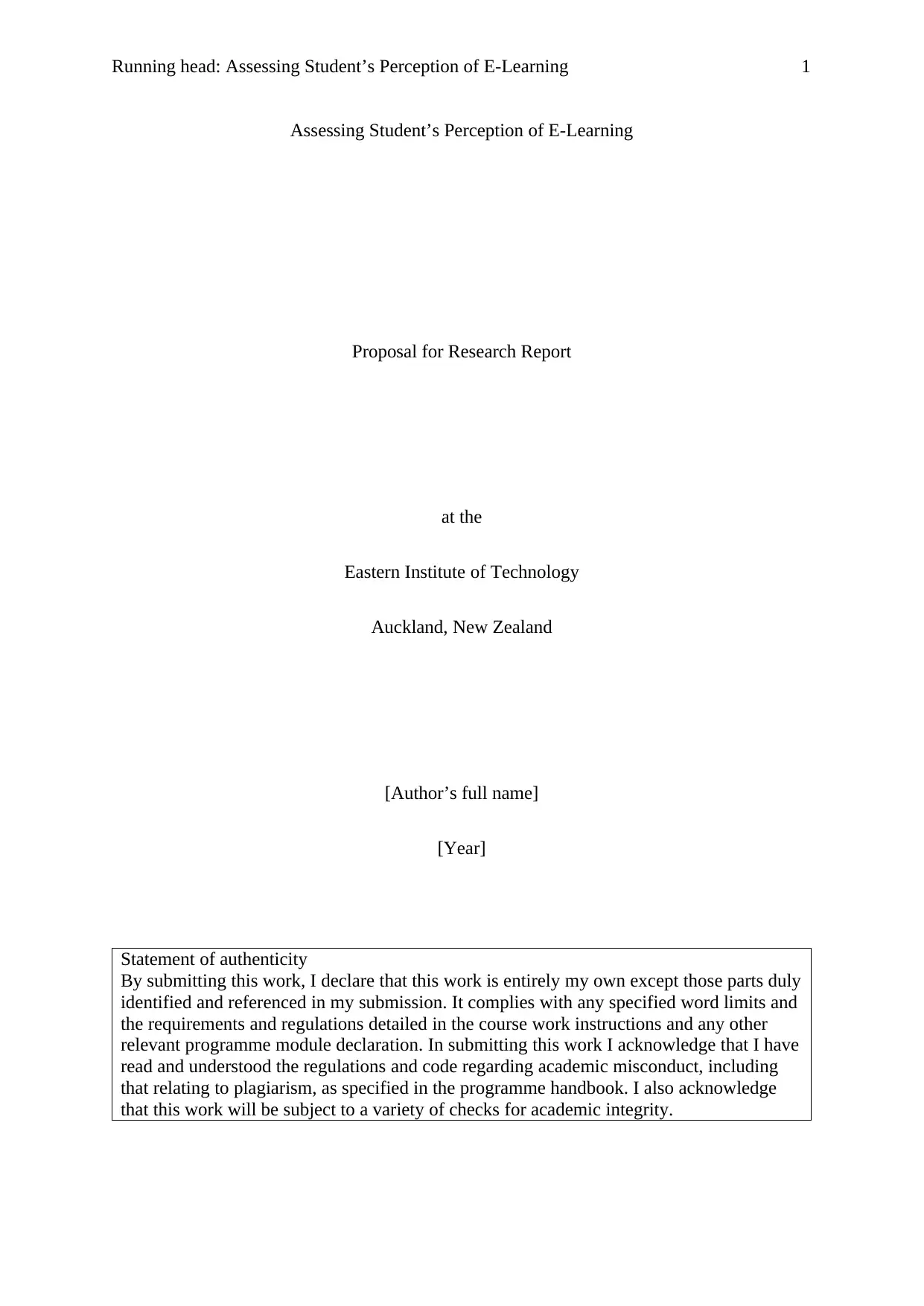
Running head: Assessing Student’s Perception of E-Learning 1
Assessing Student’s Perception of E-Learning
Proposal for Research Report
at the
Eastern Institute of Technology
Auckland, New Zealand
[Author’s full name]
[Year]
Statement of authenticity
By submitting this work, I declare that this work is entirely my own except those parts duly
identified and referenced in my submission. It complies with any specified word limits and
the requirements and regulations detailed in the course work instructions and any other
relevant programme module declaration. In submitting this work I acknowledge that I have
read and understood the regulations and code regarding academic misconduct, including
that relating to plagiarism, as specified in the programme handbook. I also acknowledge
that this work will be subject to a variety of checks for academic integrity.
Assessing Student’s Perception of E-Learning
Proposal for Research Report
at the
Eastern Institute of Technology
Auckland, New Zealand
[Author’s full name]
[Year]
Statement of authenticity
By submitting this work, I declare that this work is entirely my own except those parts duly
identified and referenced in my submission. It complies with any specified word limits and
the requirements and regulations detailed in the course work instructions and any other
relevant programme module declaration. In submitting this work I acknowledge that I have
read and understood the regulations and code regarding academic misconduct, including
that relating to plagiarism, as specified in the programme handbook. I also acknowledge
that this work will be subject to a variety of checks for academic integrity.
Paraphrase This Document
Need a fresh take? Get an instant paraphrase of this document with our AI Paraphraser
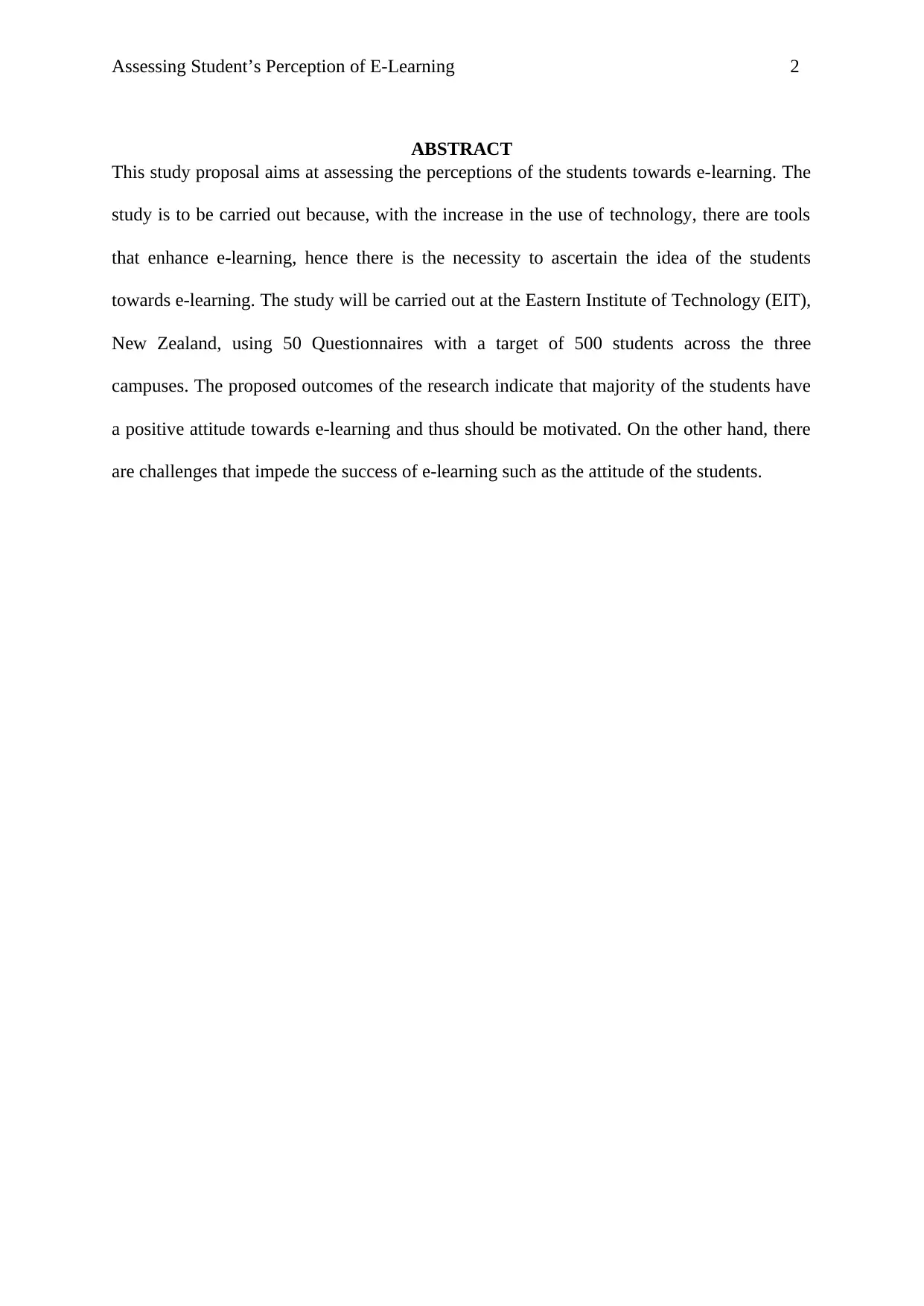
Assessing Student’s Perception of E-Learning 2
ABSTRACT
This study proposal aims at assessing the perceptions of the students towards e-learning. The
study is to be carried out because, with the increase in the use of technology, there are tools
that enhance e-learning, hence there is the necessity to ascertain the idea of the students
towards e-learning. The study will be carried out at the Eastern Institute of Technology (EIT),
New Zealand, using 50 Questionnaires with a target of 500 students across the three
campuses. The proposed outcomes of the research indicate that majority of the students have
a positive attitude towards e-learning and thus should be motivated. On the other hand, there
are challenges that impede the success of e-learning such as the attitude of the students.
ABSTRACT
This study proposal aims at assessing the perceptions of the students towards e-learning. The
study is to be carried out because, with the increase in the use of technology, there are tools
that enhance e-learning, hence there is the necessity to ascertain the idea of the students
towards e-learning. The study will be carried out at the Eastern Institute of Technology (EIT),
New Zealand, using 50 Questionnaires with a target of 500 students across the three
campuses. The proposed outcomes of the research indicate that majority of the students have
a positive attitude towards e-learning and thus should be motivated. On the other hand, there
are challenges that impede the success of e-learning such as the attitude of the students.
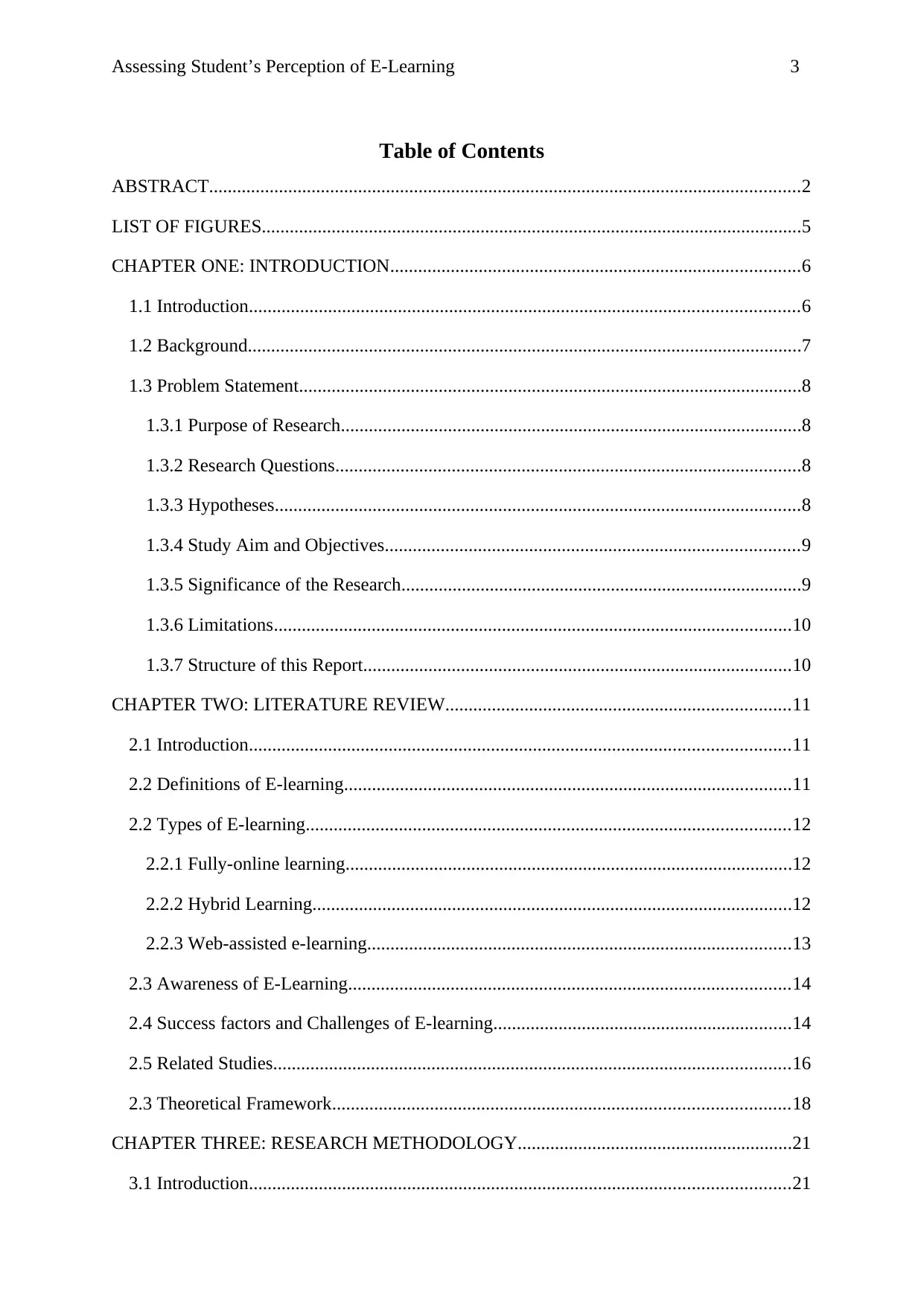
Assessing Student’s Perception of E-Learning 3
Table of Contents
ABSTRACT...............................................................................................................................2
LIST OF FIGURES....................................................................................................................5
CHAPTER ONE: INTRODUCTION........................................................................................6
1.1 Introduction......................................................................................................................6
1.2 Background.......................................................................................................................7
1.3 Problem Statement............................................................................................................8
1.3.1 Purpose of Research...................................................................................................8
1.3.2 Research Questions....................................................................................................8
1.3.3 Hypotheses.................................................................................................................8
1.3.4 Study Aim and Objectives.........................................................................................9
1.3.5 Significance of the Research......................................................................................9
1.3.6 Limitations...............................................................................................................10
1.3.7 Structure of this Report............................................................................................10
CHAPTER TWO: LITERATURE REVIEW..........................................................................11
2.1 Introduction....................................................................................................................11
2.2 Definitions of E-learning................................................................................................11
2.2 Types of E-learning........................................................................................................12
2.2.1 Fully-online learning................................................................................................12
2.2.2 Hybrid Learning.......................................................................................................12
2.2.3 Web-assisted e-learning...........................................................................................13
2.3 Awareness of E-Learning...............................................................................................14
2.4 Success factors and Challenges of E-learning................................................................14
2.5 Related Studies...............................................................................................................16
2.3 Theoretical Framework..................................................................................................18
CHAPTER THREE: RESEARCH METHODOLOGY...........................................................21
3.1 Introduction....................................................................................................................21
Table of Contents
ABSTRACT...............................................................................................................................2
LIST OF FIGURES....................................................................................................................5
CHAPTER ONE: INTRODUCTION........................................................................................6
1.1 Introduction......................................................................................................................6
1.2 Background.......................................................................................................................7
1.3 Problem Statement............................................................................................................8
1.3.1 Purpose of Research...................................................................................................8
1.3.2 Research Questions....................................................................................................8
1.3.3 Hypotheses.................................................................................................................8
1.3.4 Study Aim and Objectives.........................................................................................9
1.3.5 Significance of the Research......................................................................................9
1.3.6 Limitations...............................................................................................................10
1.3.7 Structure of this Report............................................................................................10
CHAPTER TWO: LITERATURE REVIEW..........................................................................11
2.1 Introduction....................................................................................................................11
2.2 Definitions of E-learning................................................................................................11
2.2 Types of E-learning........................................................................................................12
2.2.1 Fully-online learning................................................................................................12
2.2.2 Hybrid Learning.......................................................................................................12
2.2.3 Web-assisted e-learning...........................................................................................13
2.3 Awareness of E-Learning...............................................................................................14
2.4 Success factors and Challenges of E-learning................................................................14
2.5 Related Studies...............................................................................................................16
2.3 Theoretical Framework..................................................................................................18
CHAPTER THREE: RESEARCH METHODOLOGY...........................................................21
3.1 Introduction....................................................................................................................21
⊘ This is a preview!⊘
Do you want full access?
Subscribe today to unlock all pages.

Trusted by 1+ million students worldwide
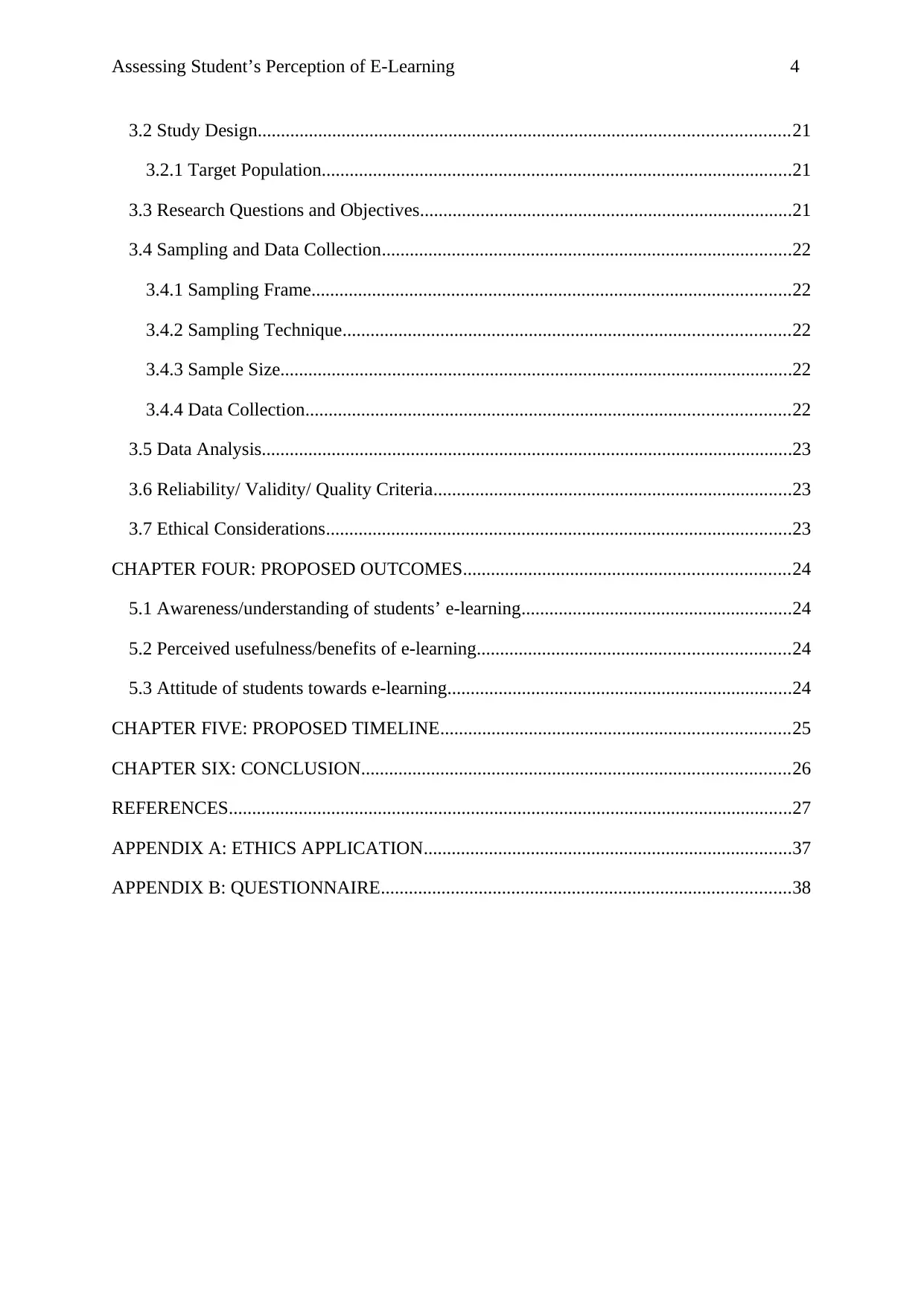
Assessing Student’s Perception of E-Learning 4
3.2 Study Design..................................................................................................................21
3.2.1 Target Population.....................................................................................................21
3.3 Research Questions and Objectives................................................................................21
3.4 Sampling and Data Collection........................................................................................22
3.4.1 Sampling Frame.......................................................................................................22
3.4.2 Sampling Technique................................................................................................22
3.4.3 Sample Size..............................................................................................................22
3.4.4 Data Collection........................................................................................................22
3.5 Data Analysis..................................................................................................................23
3.6 Reliability/ Validity/ Quality Criteria.............................................................................23
3.7 Ethical Considerations....................................................................................................23
CHAPTER FOUR: PROPOSED OUTCOMES......................................................................24
5.1 Awareness/understanding of students’ e-learning..........................................................24
5.2 Perceived usefulness/benefits of e-learning...................................................................24
5.3 Attitude of students towards e-learning..........................................................................24
CHAPTER FIVE: PROPOSED TIMELINE...........................................................................25
CHAPTER SIX: CONCLUSION............................................................................................26
REFERENCES.........................................................................................................................27
APPENDIX A: ETHICS APPLICATION...............................................................................37
APPENDIX B: QUESTIONNAIRE........................................................................................38
3.2 Study Design..................................................................................................................21
3.2.1 Target Population.....................................................................................................21
3.3 Research Questions and Objectives................................................................................21
3.4 Sampling and Data Collection........................................................................................22
3.4.1 Sampling Frame.......................................................................................................22
3.4.2 Sampling Technique................................................................................................22
3.4.3 Sample Size..............................................................................................................22
3.4.4 Data Collection........................................................................................................22
3.5 Data Analysis..................................................................................................................23
3.6 Reliability/ Validity/ Quality Criteria.............................................................................23
3.7 Ethical Considerations....................................................................................................23
CHAPTER FOUR: PROPOSED OUTCOMES......................................................................24
5.1 Awareness/understanding of students’ e-learning..........................................................24
5.2 Perceived usefulness/benefits of e-learning...................................................................24
5.3 Attitude of students towards e-learning..........................................................................24
CHAPTER FIVE: PROPOSED TIMELINE...........................................................................25
CHAPTER SIX: CONCLUSION............................................................................................26
REFERENCES.........................................................................................................................27
APPENDIX A: ETHICS APPLICATION...............................................................................37
APPENDIX B: QUESTIONNAIRE........................................................................................38
Paraphrase This Document
Need a fresh take? Get an instant paraphrase of this document with our AI Paraphraser
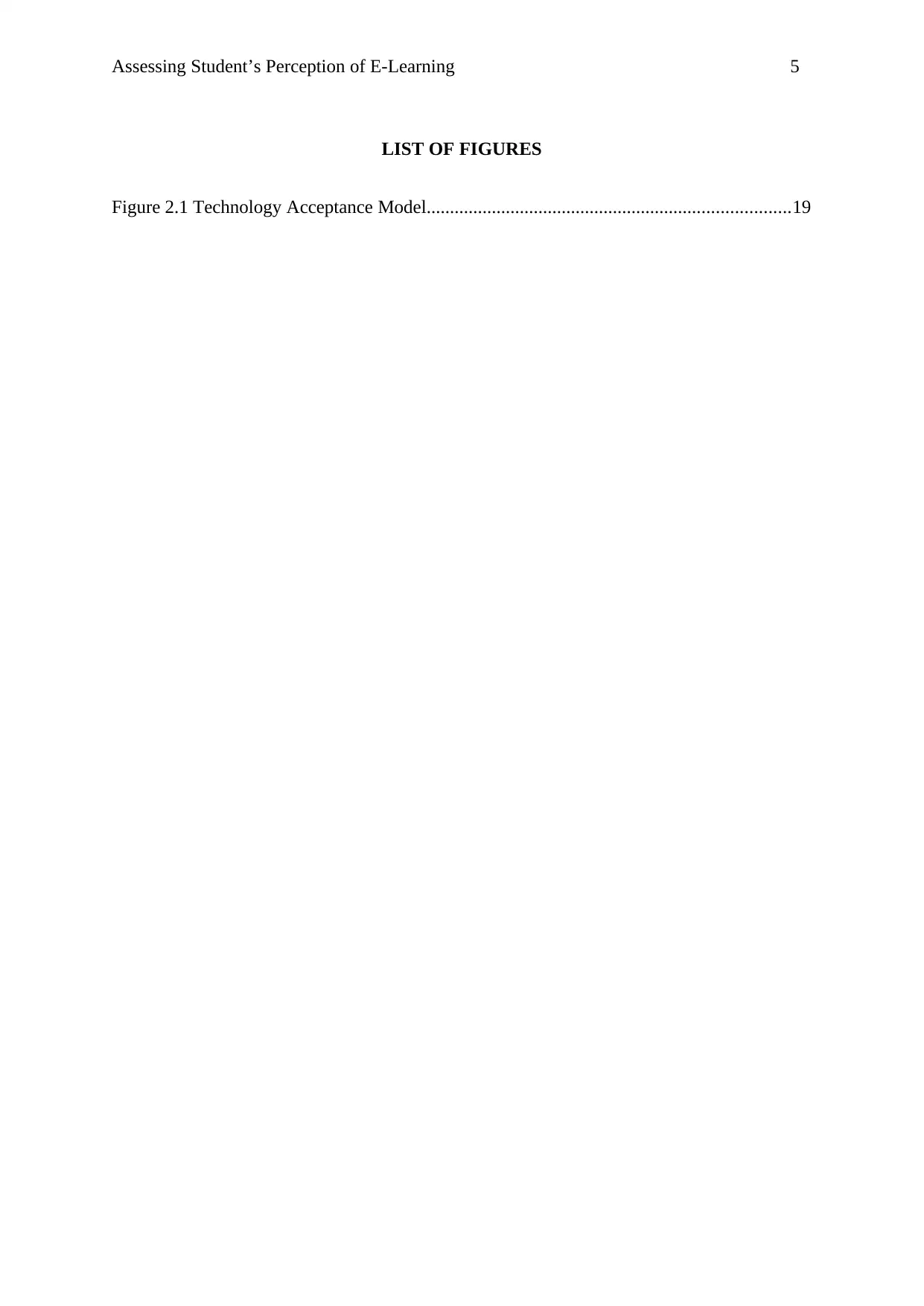
Assessing Student’s Perception of E-Learning 5
LIST OF FIGURES
Figure 2.1 Technology Acceptance Model..............................................................................19
LIST OF FIGURES
Figure 2.1 Technology Acceptance Model..............................................................................19

Assessing Student’s Perception of E-Learning 6
CHAPTER ONE: INTRODUCTION
1.1 Introduction
The perception of students towards e-learning in advance education can be determined by a
number of factors such as age, sex, former practise in computers, reception of technology and
personal styles of learning (Park, 2009; Rossing et al., 2012). Several studies have been
carried out on e-learning, but still not much is known with regard to the perception of the
students’ online learning (Sun et al., 2008), as a result there is required further research so as
to acquire more understanding on this subject. Other additional authors like (Keramati,
Afshari-Mofrad & Kamrani, 2011; Bertea 2009; Garrison, 2011; Park, 2009; Liaw & Haung
2011; Gormley et al., 2009; Zaharias & Poylymenakou, 2009; Moore, Dickson-Deane, &
Galyen, 2011; Ssemugabi & de Villiers 2010) have carried out studies on e-learning with
regard to the perception of students in different disciplines, however, none of them have
considered the students’ perceptions of e-learning in the faculty of both Education and
Commerce.
Ncube, Dube, & Ngulube (2014) argues that modern technological developments have
forcefully influenced institutions of higher education to adopt e-learning worldwide. Kulier et
al. (2008) and Kukulska-Hulme et al. (2011) observe that learning in higher education has
universally and frequently implemented the use of e-learning in higher education. Conole, &
Alevizou (2010); Ghirardin (2011); Park (2009) argue that worldwide use of e-learning has
been fuelled by the progressing learning environment and the increase in the demand for
education not offered on the university campus.
E-learning is a type of educational training that can be conveyed by the use of a CD-ROM
over the LAN (Local Area Network), or on the Internet, in addition to Electronic
Performance Support Systems (EPSS) and as distance learning. The benefits of e-learning
cannot be underestimated: it enables the students to study at their own speed, it makes it
CHAPTER ONE: INTRODUCTION
1.1 Introduction
The perception of students towards e-learning in advance education can be determined by a
number of factors such as age, sex, former practise in computers, reception of technology and
personal styles of learning (Park, 2009; Rossing et al., 2012). Several studies have been
carried out on e-learning, but still not much is known with regard to the perception of the
students’ online learning (Sun et al., 2008), as a result there is required further research so as
to acquire more understanding on this subject. Other additional authors like (Keramati,
Afshari-Mofrad & Kamrani, 2011; Bertea 2009; Garrison, 2011; Park, 2009; Liaw & Haung
2011; Gormley et al., 2009; Zaharias & Poylymenakou, 2009; Moore, Dickson-Deane, &
Galyen, 2011; Ssemugabi & de Villiers 2010) have carried out studies on e-learning with
regard to the perception of students in different disciplines, however, none of them have
considered the students’ perceptions of e-learning in the faculty of both Education and
Commerce.
Ncube, Dube, & Ngulube (2014) argues that modern technological developments have
forcefully influenced institutions of higher education to adopt e-learning worldwide. Kulier et
al. (2008) and Kukulska-Hulme et al. (2011) observe that learning in higher education has
universally and frequently implemented the use of e-learning in higher education. Conole, &
Alevizou (2010); Ghirardin (2011); Park (2009) argue that worldwide use of e-learning has
been fuelled by the progressing learning environment and the increase in the demand for
education not offered on the university campus.
E-learning is a type of educational training that can be conveyed by the use of a CD-ROM
over the LAN (Local Area Network), or on the Internet, in addition to Electronic
Performance Support Systems (EPSS) and as distance learning. The benefits of e-learning
cannot be underestimated: it enables the students to study at their own speed, it makes it
⊘ This is a preview!⊘
Do you want full access?
Subscribe today to unlock all pages.

Trusted by 1+ million students worldwide
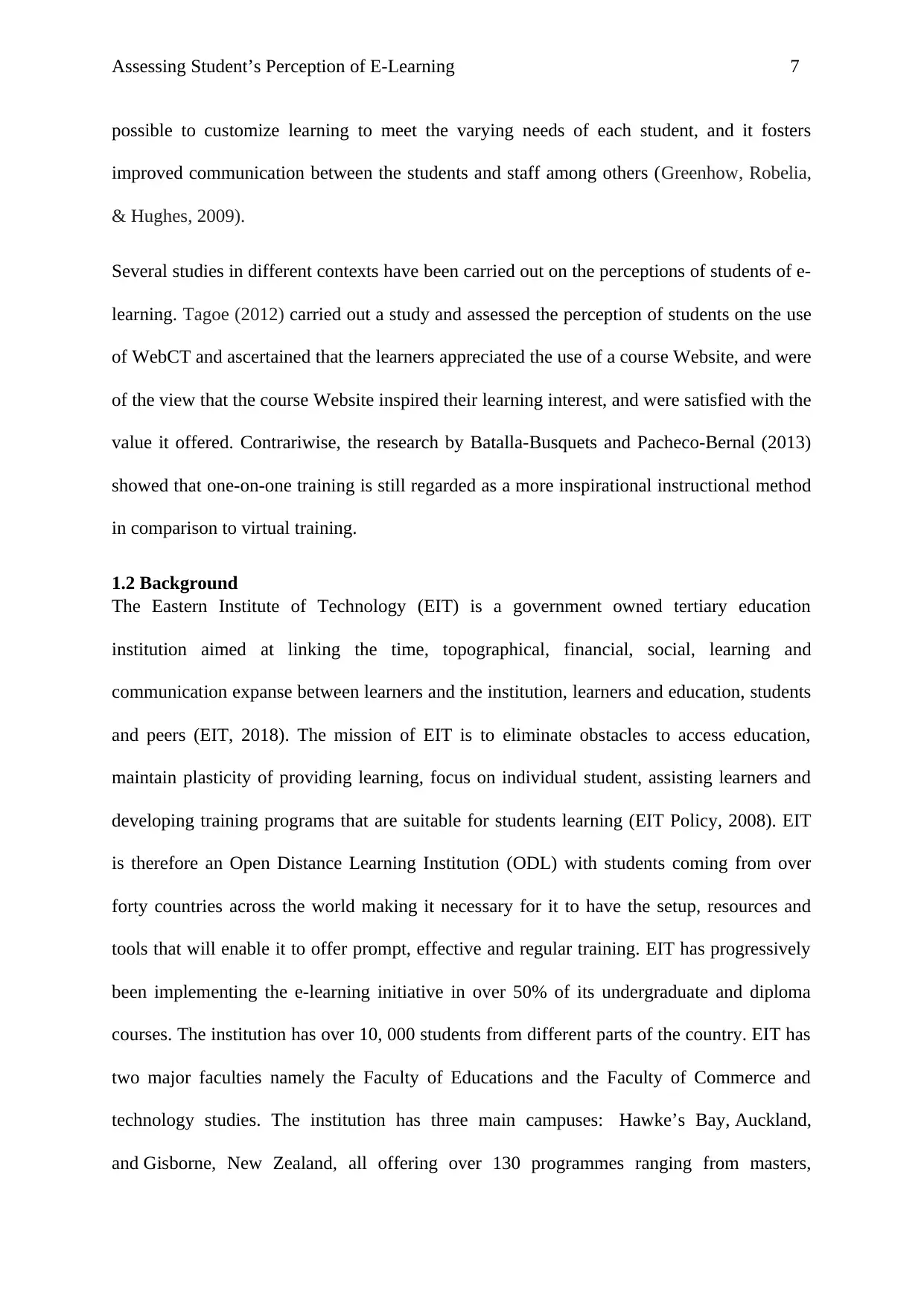
Assessing Student’s Perception of E-Learning 7
possible to customize learning to meet the varying needs of each student, and it fosters
improved communication between the students and staff among others (Greenhow, Robelia,
& Hughes, 2009).
Several studies in different contexts have been carried out on the perceptions of students of e-
learning. Tagoe (2012) carried out a study and assessed the perception of students on the use
of WebCT and ascertained that the learners appreciated the use of a course Website, and were
of the view that the course Website inspired their learning interest, and were satisfied with the
value it offered. Contrariwise, the research by Batalla-Busquets and Pacheco-Bernal (2013)
showed that one-on-one training is still regarded as a more inspirational instructional method
in comparison to virtual training.
1.2 Background
The Eastern Institute of Technology (EIT) is a government owned tertiary education
institution aimed at linking the time, topographical, financial, social, learning and
communication expanse between learners and the institution, learners and education, students
and peers (EIT, 2018). The mission of EIT is to eliminate obstacles to access education,
maintain plasticity of providing learning, focus on individual student, assisting learners and
developing training programs that are suitable for students learning (EIT Policy, 2008). EIT
is therefore an Open Distance Learning Institution (ODL) with students coming from over
forty countries across the world making it necessary for it to have the setup, resources and
tools that will enable it to offer prompt, effective and regular training. EIT has progressively
been implementing the e-learning initiative in over 50% of its undergraduate and diploma
courses. The institution has over 10, 000 students from different parts of the country. EIT has
two major faculties namely the Faculty of Educations and the Faculty of Commerce and
technology studies. The institution has three main campuses: Hawke’s Bay, Auckland,
and Gisborne, New Zealand, all offering over 130 programmes ranging from masters,
possible to customize learning to meet the varying needs of each student, and it fosters
improved communication between the students and staff among others (Greenhow, Robelia,
& Hughes, 2009).
Several studies in different contexts have been carried out on the perceptions of students of e-
learning. Tagoe (2012) carried out a study and assessed the perception of students on the use
of WebCT and ascertained that the learners appreciated the use of a course Website, and were
of the view that the course Website inspired their learning interest, and were satisfied with the
value it offered. Contrariwise, the research by Batalla-Busquets and Pacheco-Bernal (2013)
showed that one-on-one training is still regarded as a more inspirational instructional method
in comparison to virtual training.
1.2 Background
The Eastern Institute of Technology (EIT) is a government owned tertiary education
institution aimed at linking the time, topographical, financial, social, learning and
communication expanse between learners and the institution, learners and education, students
and peers (EIT, 2018). The mission of EIT is to eliminate obstacles to access education,
maintain plasticity of providing learning, focus on individual student, assisting learners and
developing training programs that are suitable for students learning (EIT Policy, 2008). EIT
is therefore an Open Distance Learning Institution (ODL) with students coming from over
forty countries across the world making it necessary for it to have the setup, resources and
tools that will enable it to offer prompt, effective and regular training. EIT has progressively
been implementing the e-learning initiative in over 50% of its undergraduate and diploma
courses. The institution has over 10, 000 students from different parts of the country. EIT has
two major faculties namely the Faculty of Educations and the Faculty of Commerce and
technology studies. The institution has three main campuses: Hawke’s Bay, Auckland,
and Gisborne, New Zealand, all offering over 130 programmes ranging from masters,
Paraphrase This Document
Need a fresh take? Get an instant paraphrase of this document with our AI Paraphraser
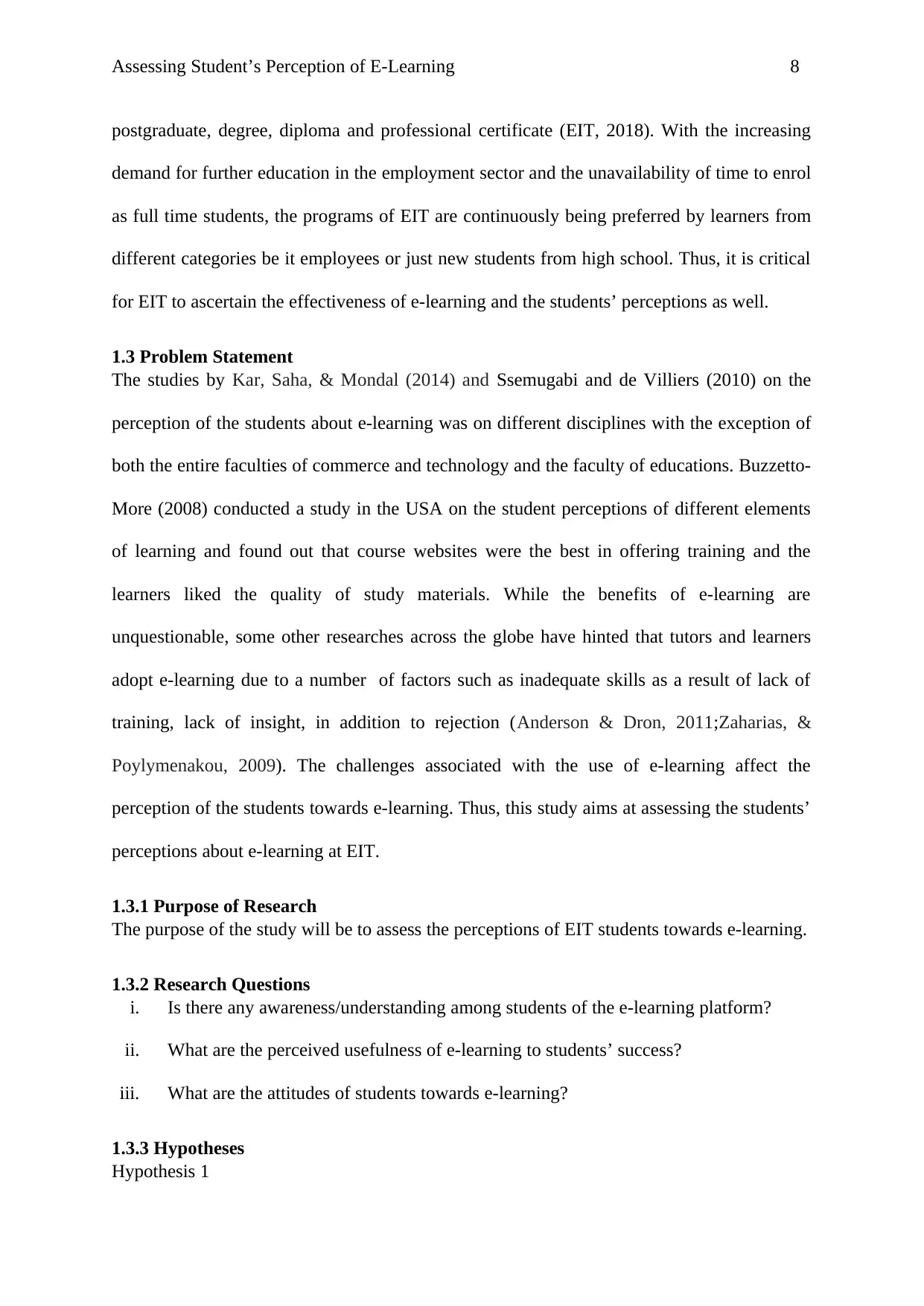
Assessing Student’s Perception of E-Learning 8
postgraduate, degree, diploma and professional certificate (EIT, 2018). With the increasing
demand for further education in the employment sector and the unavailability of time to enrol
as full time students, the programs of EIT are continuously being preferred by learners from
different categories be it employees or just new students from high school. Thus, it is critical
for EIT to ascertain the effectiveness of e-learning and the students’ perceptions as well.
1.3 Problem Statement
The studies by Kar, Saha, & Mondal (2014) and Ssemugabi and de Villiers (2010) on the
perception of the students about e-learning was on different disciplines with the exception of
both the entire faculties of commerce and technology and the faculty of educations. Buzzetto-
More (2008) conducted a study in the USA on the student perceptions of different elements
of learning and found out that course websites were the best in offering training and the
learners liked the quality of study materials. While the benefits of e-learning are
unquestionable, some other researches across the globe have hinted that tutors and learners
adopt e-learning due to a number of factors such as inadequate skills as a result of lack of
training, lack of insight, in addition to rejection (Anderson & Dron, 2011;Zaharias, &
Poylymenakou, 2009). The challenges associated with the use of e-learning affect the
perception of the students towards e-learning. Thus, this study aims at assessing the students’
perceptions about e-learning at EIT.
1.3.1 Purpose of Research
The purpose of the study will be to assess the perceptions of EIT students towards e-learning.
1.3.2 Research Questions
i. Is there any awareness/understanding among students of the e-learning platform?
ii. What are the perceived usefulness of e-learning to students’ success?
iii. What are the attitudes of students towards e-learning?
1.3.3 Hypotheses
Hypothesis 1
postgraduate, degree, diploma and professional certificate (EIT, 2018). With the increasing
demand for further education in the employment sector and the unavailability of time to enrol
as full time students, the programs of EIT are continuously being preferred by learners from
different categories be it employees or just new students from high school. Thus, it is critical
for EIT to ascertain the effectiveness of e-learning and the students’ perceptions as well.
1.3 Problem Statement
The studies by Kar, Saha, & Mondal (2014) and Ssemugabi and de Villiers (2010) on the
perception of the students about e-learning was on different disciplines with the exception of
both the entire faculties of commerce and technology and the faculty of educations. Buzzetto-
More (2008) conducted a study in the USA on the student perceptions of different elements
of learning and found out that course websites were the best in offering training and the
learners liked the quality of study materials. While the benefits of e-learning are
unquestionable, some other researches across the globe have hinted that tutors and learners
adopt e-learning due to a number of factors such as inadequate skills as a result of lack of
training, lack of insight, in addition to rejection (Anderson & Dron, 2011;Zaharias, &
Poylymenakou, 2009). The challenges associated with the use of e-learning affect the
perception of the students towards e-learning. Thus, this study aims at assessing the students’
perceptions about e-learning at EIT.
1.3.1 Purpose of Research
The purpose of the study will be to assess the perceptions of EIT students towards e-learning.
1.3.2 Research Questions
i. Is there any awareness/understanding among students of the e-learning platform?
ii. What are the perceived usefulness of e-learning to students’ success?
iii. What are the attitudes of students towards e-learning?
1.3.3 Hypotheses
Hypothesis 1
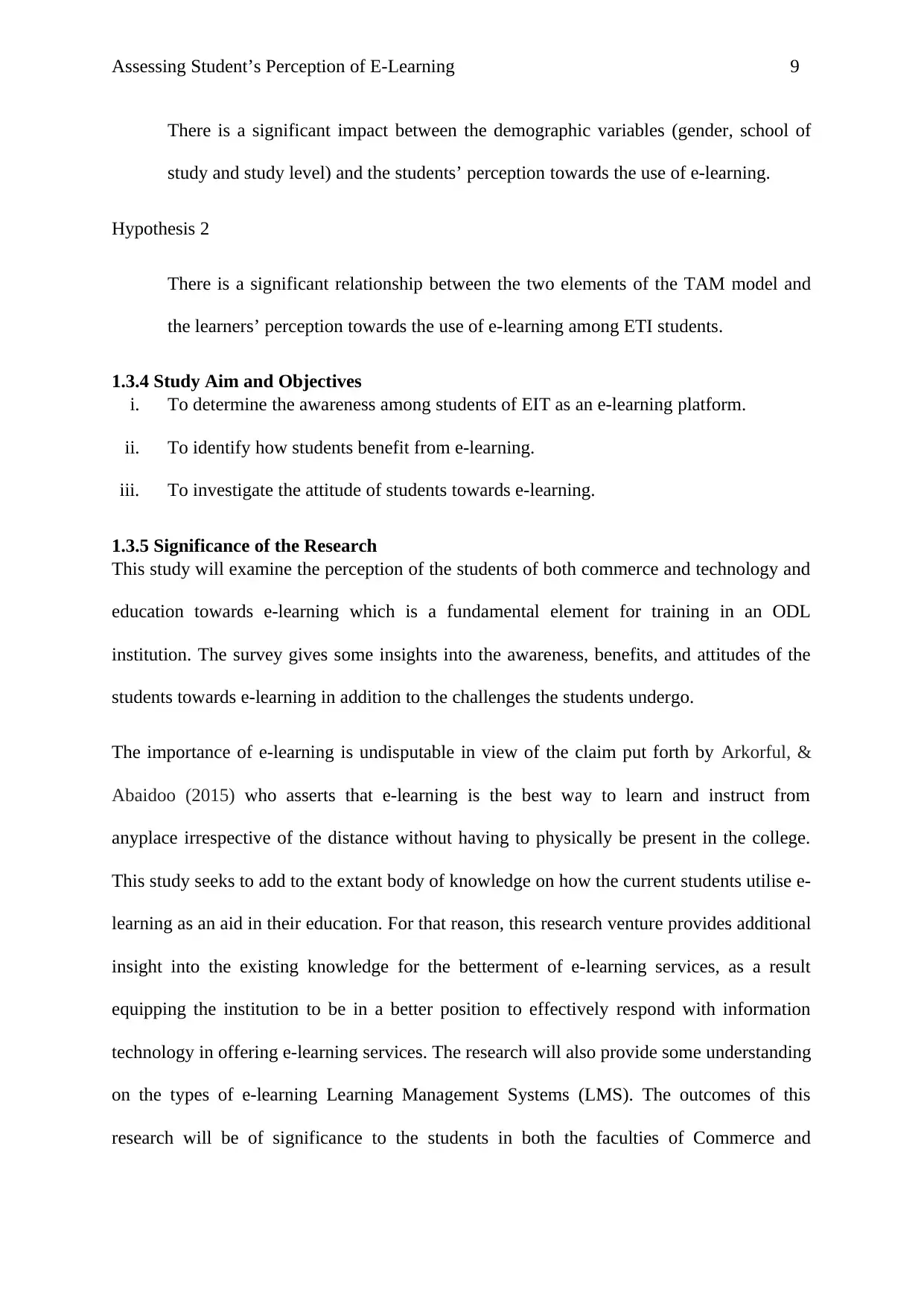
Assessing Student’s Perception of E-Learning 9
There is a significant impact between the demographic variables (gender, school of
study and study level) and the students’ perception towards the use of e-learning.
Hypothesis 2
There is a significant relationship between the two elements of the TAM model and
the learners’ perception towards the use of e-learning among ETI students.
1.3.4 Study Aim and Objectives
i. To determine the awareness among students of EIT as an e-learning platform.
ii. To identify how students benefit from e-learning.
iii. To investigate the attitude of students towards e-learning.
1.3.5 Significance of the Research
This study will examine the perception of the students of both commerce and technology and
education towards e-learning which is a fundamental element for training in an ODL
institution. The survey gives some insights into the awareness, benefits, and attitudes of the
students towards e-learning in addition to the challenges the students undergo.
The importance of e-learning is undisputable in view of the claim put forth by Arkorful, &
Abaidoo (2015) who asserts that e-learning is the best way to learn and instruct from
anyplace irrespective of the distance without having to physically be present in the college.
This study seeks to add to the extant body of knowledge on how the current students utilise e-
learning as an aid in their education. For that reason, this research venture provides additional
insight into the existing knowledge for the betterment of e-learning services, as a result
equipping the institution to be in a better position to effectively respond with information
technology in offering e-learning services. The research will also provide some understanding
on the types of e-learning Learning Management Systems (LMS). The outcomes of this
research will be of significance to the students in both the faculties of Commerce and
There is a significant impact between the demographic variables (gender, school of
study and study level) and the students’ perception towards the use of e-learning.
Hypothesis 2
There is a significant relationship between the two elements of the TAM model and
the learners’ perception towards the use of e-learning among ETI students.
1.3.4 Study Aim and Objectives
i. To determine the awareness among students of EIT as an e-learning platform.
ii. To identify how students benefit from e-learning.
iii. To investigate the attitude of students towards e-learning.
1.3.5 Significance of the Research
This study will examine the perception of the students of both commerce and technology and
education towards e-learning which is a fundamental element for training in an ODL
institution. The survey gives some insights into the awareness, benefits, and attitudes of the
students towards e-learning in addition to the challenges the students undergo.
The importance of e-learning is undisputable in view of the claim put forth by Arkorful, &
Abaidoo (2015) who asserts that e-learning is the best way to learn and instruct from
anyplace irrespective of the distance without having to physically be present in the college.
This study seeks to add to the extant body of knowledge on how the current students utilise e-
learning as an aid in their education. For that reason, this research venture provides additional
insight into the existing knowledge for the betterment of e-learning services, as a result
equipping the institution to be in a better position to effectively respond with information
technology in offering e-learning services. The research will also provide some understanding
on the types of e-learning Learning Management Systems (LMS). The outcomes of this
research will be of significance to the students in both the faculties of Commerce and
⊘ This is a preview!⊘
Do you want full access?
Subscribe today to unlock all pages.

Trusted by 1+ million students worldwide
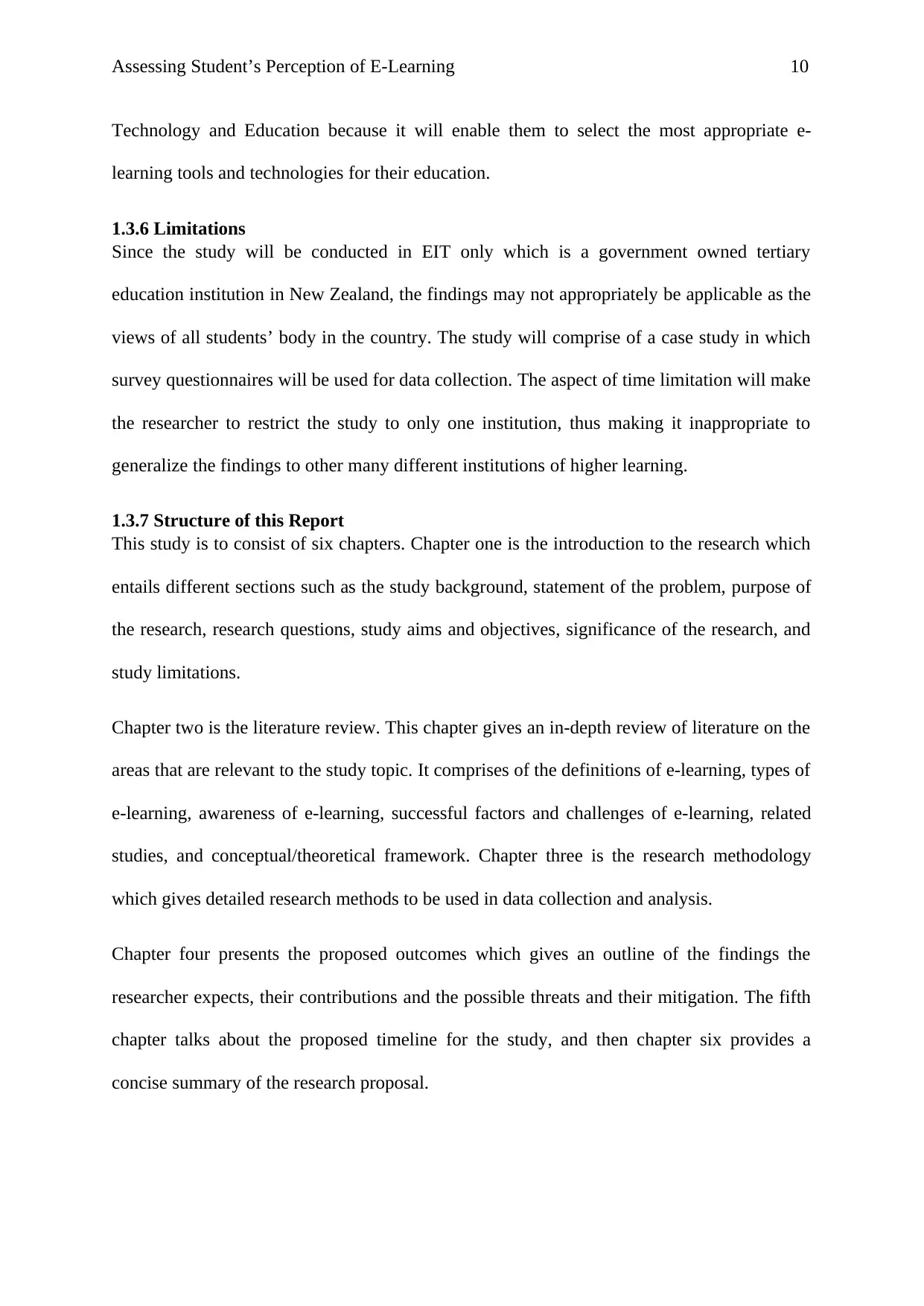
Assessing Student’s Perception of E-Learning 10
Technology and Education because it will enable them to select the most appropriate e-
learning tools and technologies for their education.
1.3.6 Limitations
Since the study will be conducted in EIT only which is a government owned tertiary
education institution in New Zealand, the findings may not appropriately be applicable as the
views of all students’ body in the country. The study will comprise of a case study in which
survey questionnaires will be used for data collection. The aspect of time limitation will make
the researcher to restrict the study to only one institution, thus making it inappropriate to
generalize the findings to other many different institutions of higher learning.
1.3.7 Structure of this Report
This study is to consist of six chapters. Chapter one is the introduction to the research which
entails different sections such as the study background, statement of the problem, purpose of
the research, research questions, study aims and objectives, significance of the research, and
study limitations.
Chapter two is the literature review. This chapter gives an in-depth review of literature on the
areas that are relevant to the study topic. It comprises of the definitions of e-learning, types of
e-learning, awareness of e-learning, successful factors and challenges of e-learning, related
studies, and conceptual/theoretical framework. Chapter three is the research methodology
which gives detailed research methods to be used in data collection and analysis.
Chapter four presents the proposed outcomes which gives an outline of the findings the
researcher expects, their contributions and the possible threats and their mitigation. The fifth
chapter talks about the proposed timeline for the study, and then chapter six provides a
concise summary of the research proposal.
Technology and Education because it will enable them to select the most appropriate e-
learning tools and technologies for their education.
1.3.6 Limitations
Since the study will be conducted in EIT only which is a government owned tertiary
education institution in New Zealand, the findings may not appropriately be applicable as the
views of all students’ body in the country. The study will comprise of a case study in which
survey questionnaires will be used for data collection. The aspect of time limitation will make
the researcher to restrict the study to only one institution, thus making it inappropriate to
generalize the findings to other many different institutions of higher learning.
1.3.7 Structure of this Report
This study is to consist of six chapters. Chapter one is the introduction to the research which
entails different sections such as the study background, statement of the problem, purpose of
the research, research questions, study aims and objectives, significance of the research, and
study limitations.
Chapter two is the literature review. This chapter gives an in-depth review of literature on the
areas that are relevant to the study topic. It comprises of the definitions of e-learning, types of
e-learning, awareness of e-learning, successful factors and challenges of e-learning, related
studies, and conceptual/theoretical framework. Chapter three is the research methodology
which gives detailed research methods to be used in data collection and analysis.
Chapter four presents the proposed outcomes which gives an outline of the findings the
researcher expects, their contributions and the possible threats and their mitigation. The fifth
chapter talks about the proposed timeline for the study, and then chapter six provides a
concise summary of the research proposal.
Paraphrase This Document
Need a fresh take? Get an instant paraphrase of this document with our AI Paraphraser
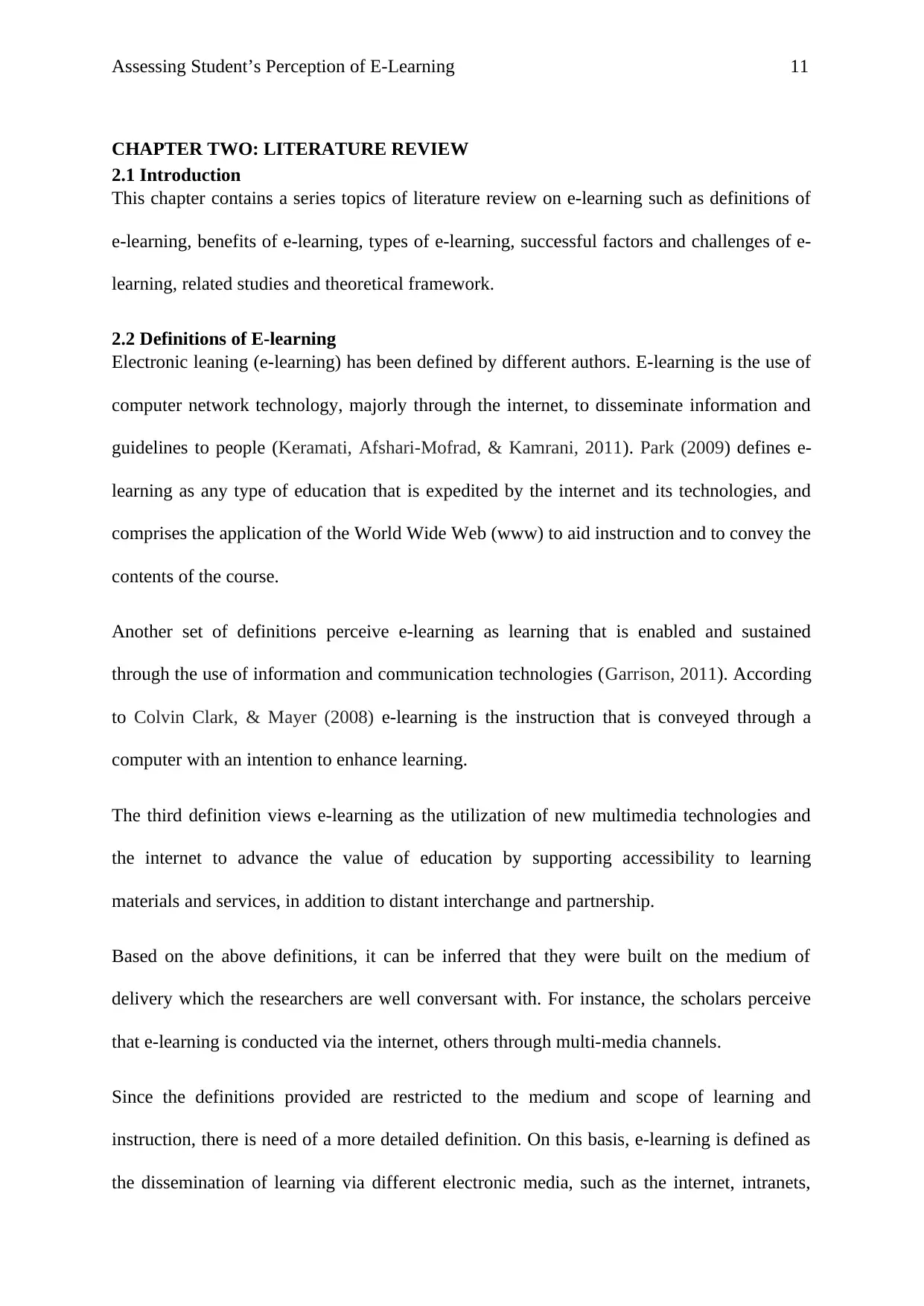
Assessing Student’s Perception of E-Learning 11
CHAPTER TWO: LITERATURE REVIEW
2.1 Introduction
This chapter contains a series topics of literature review on e-learning such as definitions of
e-learning, benefits of e-learning, types of e-learning, successful factors and challenges of e-
learning, related studies and theoretical framework.
2.2 Definitions of E-learning
Electronic leaning (e-learning) has been defined by different authors. E-learning is the use of
computer network technology, majorly through the internet, to disseminate information and
guidelines to people (Keramati, Afshari-Mofrad, & Kamrani, 2011). Park (2009) defines e-
learning as any type of education that is expedited by the internet and its technologies, and
comprises the application of the World Wide Web (www) to aid instruction and to convey the
contents of the course.
Another set of definitions perceive e-learning as learning that is enabled and sustained
through the use of information and communication technologies (Garrison, 2011). According
to Colvin Clark, & Mayer (2008) e-learning is the instruction that is conveyed through a
computer with an intention to enhance learning.
The third definition views e-learning as the utilization of new multimedia technologies and
the internet to advance the value of education by supporting accessibility to learning
materials and services, in addition to distant interchange and partnership.
Based on the above definitions, it can be inferred that they were built on the medium of
delivery which the researchers are well conversant with. For instance, the scholars perceive
that e-learning is conducted via the internet, others through multi-media channels.
Since the definitions provided are restricted to the medium and scope of learning and
instruction, there is need of a more detailed definition. On this basis, e-learning is defined as
the dissemination of learning via different electronic media, such as the internet, intranets,
CHAPTER TWO: LITERATURE REVIEW
2.1 Introduction
This chapter contains a series topics of literature review on e-learning such as definitions of
e-learning, benefits of e-learning, types of e-learning, successful factors and challenges of e-
learning, related studies and theoretical framework.
2.2 Definitions of E-learning
Electronic leaning (e-learning) has been defined by different authors. E-learning is the use of
computer network technology, majorly through the internet, to disseminate information and
guidelines to people (Keramati, Afshari-Mofrad, & Kamrani, 2011). Park (2009) defines e-
learning as any type of education that is expedited by the internet and its technologies, and
comprises the application of the World Wide Web (www) to aid instruction and to convey the
contents of the course.
Another set of definitions perceive e-learning as learning that is enabled and sustained
through the use of information and communication technologies (Garrison, 2011). According
to Colvin Clark, & Mayer (2008) e-learning is the instruction that is conveyed through a
computer with an intention to enhance learning.
The third definition views e-learning as the utilization of new multimedia technologies and
the internet to advance the value of education by supporting accessibility to learning
materials and services, in addition to distant interchange and partnership.
Based on the above definitions, it can be inferred that they were built on the medium of
delivery which the researchers are well conversant with. For instance, the scholars perceive
that e-learning is conducted via the internet, others through multi-media channels.
Since the definitions provided are restricted to the medium and scope of learning and
instruction, there is need of a more detailed definition. On this basis, e-learning is defined as
the dissemination of learning via different electronic media, such as the internet, intranets,
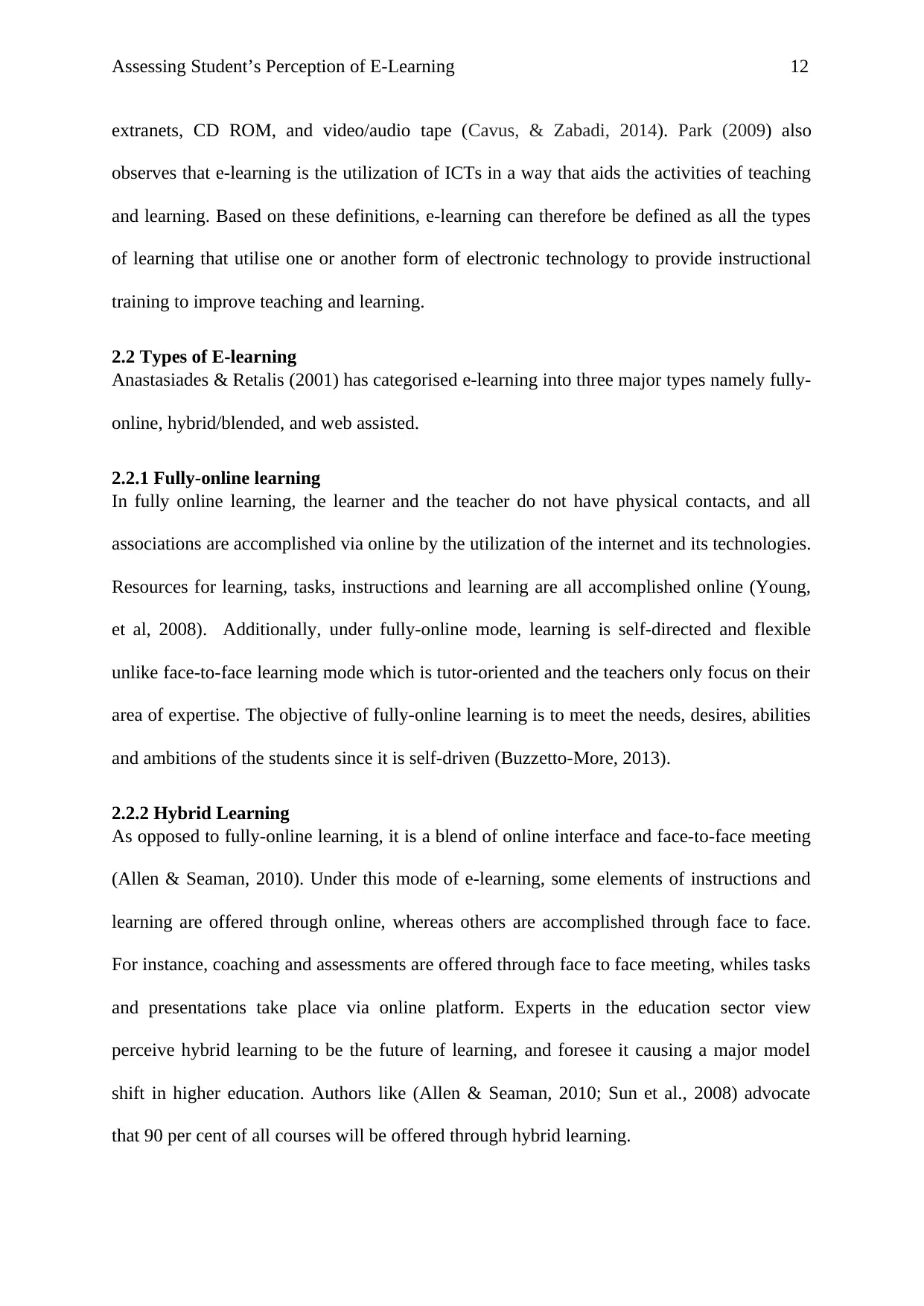
Assessing Student’s Perception of E-Learning 12
extranets, CD ROM, and video/audio tape (Cavus, & Zabadi, 2014). Park (2009) also
observes that e-learning is the utilization of ICTs in a way that aids the activities of teaching
and learning. Based on these definitions, e-learning can therefore be defined as all the types
of learning that utilise one or another form of electronic technology to provide instructional
training to improve teaching and learning.
2.2 Types of E-learning
Anastasiades & Retalis (2001) has categorised e-learning into three major types namely fully-
online, hybrid/blended, and web assisted.
2.2.1 Fully-online learning
In fully online learning, the learner and the teacher do not have physical contacts, and all
associations are accomplished via online by the utilization of the internet and its technologies.
Resources for learning, tasks, instructions and learning are all accomplished online (Young,
et al, 2008). Additionally, under fully-online mode, learning is self-directed and flexible
unlike face-to-face learning mode which is tutor-oriented and the teachers only focus on their
area of expertise. The objective of fully-online learning is to meet the needs, desires, abilities
and ambitions of the students since it is self-driven (Buzzetto-More, 2013).
2.2.2 Hybrid Learning
As opposed to fully-online learning, it is a blend of online interface and face-to-face meeting
(Allen & Seaman, 2010). Under this mode of e-learning, some elements of instructions and
learning are offered through online, whereas others are accomplished through face to face.
For instance, coaching and assessments are offered through face to face meeting, whiles tasks
and presentations take place via online platform. Experts in the education sector view
perceive hybrid learning to be the future of learning, and foresee it causing a major model
shift in higher education. Authors like (Allen & Seaman, 2010; Sun et al., 2008) advocate
that 90 per cent of all courses will be offered through hybrid learning.
extranets, CD ROM, and video/audio tape (Cavus, & Zabadi, 2014). Park (2009) also
observes that e-learning is the utilization of ICTs in a way that aids the activities of teaching
and learning. Based on these definitions, e-learning can therefore be defined as all the types
of learning that utilise one or another form of electronic technology to provide instructional
training to improve teaching and learning.
2.2 Types of E-learning
Anastasiades & Retalis (2001) has categorised e-learning into three major types namely fully-
online, hybrid/blended, and web assisted.
2.2.1 Fully-online learning
In fully online learning, the learner and the teacher do not have physical contacts, and all
associations are accomplished via online by the utilization of the internet and its technologies.
Resources for learning, tasks, instructions and learning are all accomplished online (Young,
et al, 2008). Additionally, under fully-online mode, learning is self-directed and flexible
unlike face-to-face learning mode which is tutor-oriented and the teachers only focus on their
area of expertise. The objective of fully-online learning is to meet the needs, desires, abilities
and ambitions of the students since it is self-driven (Buzzetto-More, 2013).
2.2.2 Hybrid Learning
As opposed to fully-online learning, it is a blend of online interface and face-to-face meeting
(Allen & Seaman, 2010). Under this mode of e-learning, some elements of instructions and
learning are offered through online, whereas others are accomplished through face to face.
For instance, coaching and assessments are offered through face to face meeting, whiles tasks
and presentations take place via online platform. Experts in the education sector view
perceive hybrid learning to be the future of learning, and foresee it causing a major model
shift in higher education. Authors like (Allen & Seaman, 2010; Sun et al., 2008) advocate
that 90 per cent of all courses will be offered through hybrid learning.
⊘ This is a preview!⊘
Do you want full access?
Subscribe today to unlock all pages.

Trusted by 1+ million students worldwide
1 out of 38
Related Documents
Your All-in-One AI-Powered Toolkit for Academic Success.
+13062052269
info@desklib.com
Available 24*7 on WhatsApp / Email
![[object Object]](/_next/static/media/star-bottom.7253800d.svg)
Unlock your academic potential
Copyright © 2020–2025 A2Z Services. All Rights Reserved. Developed and managed by ZUCOL.





